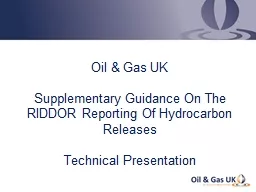

Supplementary Guidance On The RIDDOR Reporting Of Hydrocarbon Releases Technical Presentation Objectives of the Workgroup Structure of Guidance Regulatory Requirements Reporting Methodology ID: 283966
Download Presentation The PPT/PDF document "Oil & Gas UK" is the property of its rightful owner. Permission is granted to download and print the materials on this web site for personal, non-commercial use only, and to display it on your personal computer provided you do not modify the materials and that you retain all copyright notices contained in the materials. By downloading content from our website, you accept the terms of this agreement.
Slide1
Oil & Gas UK
Supplementary Guidance On The RIDDOR Reporting Of Hydrocarbon Releases
Technical PresentationSlide2
Objectives of the Workgroup
Structure of GuidanceRegulatory RequirementsReporting MethodologyTechnical AssessmentReportable LimitsAdditional RulesReporting of Non Petroleum Hydrocarbons
Hydrocarbon Release Reporting - AgendaSlide3
Produce
supplementary guidance that isFully aligned with RIDDOR 2013 requirementsWell-understood by the industryConsistently applied by the industryPrimarily focussed on petroleum hydrocarbon releasesAlso includes assessment on non-petroleum hydrocarbon releasesObjectives of WorkgroupSlide4
Petroleum Hydrocarbon Releases
Number of releases
Reportable Limit
Major
Significant
Minor
Not Reportable
2014 Guidance
Previous Guidance
Reportable LimitSlide5
Regulatory Requirements
Review of DO relating to Hydrocarbon Releases (HCR)Methodology for Assessing RIDDOR Reporting of Petroleum Hydrocarbon ReleasesDefine key words and phrasesReporting flow chartTechnical AssessmentDefines Reportable LimitsCase StudiesWorked ExamplesAppendicesConsequence AnalysisApplication of Methodology to Non-Petroleum Hydrocarbon FluidsHigh Water Content LiquidsStructure of GuidanceSlide6
Release of petroleum hydrocarbon
75 The unintentional release of petroleum hydrocarbon on or from an offshore installation which – (a) results in – (i) a fire or explosion; or (ii) the taking of action to prevent or limit the consequences of a potential fire or explosion; or (b) could cause a specified injury to, or the death of, any person.Regulatory Requirements – RIDDOR 2013Slide7
Petroleum Hydrocarbons
Well Fluids, Natural Gas, Natural Gas Liquids, Condensate, Crude OilContinuous & Discrete ReleasesGas, Vapour, Mist, LiquidConsequence Analysis
Continuous Release - Jet Fire
Continuous Release - Pool Fire
Discrete Release
- Fireball
Discrete Release
- Pool Fire
Flash fire, Explosion, Toxic Cloud, Asphyxia
, Narcosis - See Guidance
Technical Assessment – Potential for Death or a Specified InjurySlide8
RIDDOR DO 75 Assessment Flowchart Slide9
Continuous
& Discrete ReleasesConsequence AnalysisContinuous Release - Jet FireContinuous Release - Pool FireDiscrete Release - FireballDiscrete Release - Pool FireAdditional GuidanceTechnical AssessmentSlide10
Continuous
release – A continuous release is a loss of containment from a system which occurs, or has the potential to occur, for an extended period of time (minutes) prior to plant stoppage or action being taken to depressurise the system. For continuous releases, the release rate is the important factor in determining if a HCR has the potential to cause death or a specified injury.Discrete release – A discrete release is a loss of containment from a system with a fixed mass inventory where the hydrocarbon is released over a short period of time (seconds rather than minutes) and where the initial mass released has a greater hazard potential than any following continuous release. Continuous And Discrete ReleasesSlide11
Jet fire flame length ≥
1mCriterion – person must be in the flameMass flow rate for 1m flame length = 3 kg/hourEquivalent gas concentration 20% LFL at 0.5mConservatismsJet fire flame length correlationAdopted gas concentration criterionContinuous Release - Jet FireSlide12
Pool fire
flame diameter ≥ 1mCriterion – person must be in the flameMass flow rate for sustained 1m diameterpool = 100 kg/hourConservatismsLowest burn rate adopted for all liquidsAdopted reportable limit lower than calculatedContinuous Release - Pool FireSlide13
Transient analysis
Criterion – thermal dose ≥ 1000 tduSurface Emissive Power = 300 kW/m2Mass of hydrocarbons for 1000 tdu = 0.15 kgConservatismAssume person exposed to constant heat fluxDiscrete Release – FireballSlide14
Transient
analysisPool fire grows with timeCriterionAn escaping person is caught in the flameThe thermal dose received during escape ≥1000 tdu.Mass of hydrocarbons to meet criterionNatural Gas Liquids - 3 kgCondensate - 10 kgCrude Oil - 30 kgConservatismSpeed of escape
Discrete Release – Pool FireSlide15
Water Cut
Hydrocarbon liquids with ≥ 90% water by mass are not combustible and are therefore not reportableAccumulationLiquid releases are only reportable if they can form pools.If a liquid release falls to the sea and there is no pool or coating formed on equipment or the deck, it is not reportable.If a liquid release is routed directly to the drains within 0.5 m of the point of release and does not form a pool, it is not reportable. Additional Guidance – Hydrocarbon LiquidsSlide16
Reportable Limits
Type of Release
Phase
Hazard
Fluid
Reportable Limit
Continuous
Gas /
Vapour / Mist
Jet Fire
Natural
Gas
Natural
Gas Liquids
Condensate
Crude Oil
3 kg/hour
(0.0008 kg/s)
OR
20% LFL at 0.5 m
Liquid
Pool Fire
Natural Gas Liquids
Condensate
Crude Oil
100 kg/hour
(0.028 kg/s)
Discrete
Gas /
Vapour / Mist
Fireball
Natural Gas
Natural Gas Liquids
Condensate
Crude Oil
0.15 kg
Liquid
Pool Fire
Natural Gas Liquids
3 kg
Pool Fire
Condensate
10 kg
Pool Fire
Crude Oil
30 kgSlide17
Reportable Limits for Petroleum Hydrocarbon Releases – DO
75 (Appendix B of Guidance)Slide18
Reportable Limits for Non-Petroleum Hydrocarbon Fluids – DO
77 (Appendix D of Guidance)Slide19
Regulatory Requirements
Unignited Release
RIDDOR
2013
Dangerous
Occurrence
RIDDOR
Reportable
Limit
OIR/12
Wells
DO 20
No
All
releases
Pipelines
DO 21
Yes
(See HSE Website)
Only if release is within 500m zone
Release of petroleum hydrocarbons
DO 75
Yes
(See Sections 3 & 4)
All RIDDOR DO 75 reportable releases
Release of non-petroleum hydrocarbons
DO 77
Yes
(See Section 5)
Not required
Ignited Release
RIDDOR 2013
Dangerous Occurrence
RIDDOR
Reportable
Limit
OIR/12
Wells
DO 20
No
All
releases
Pipelines
DO 21
No
Only if release is within 500m zone
Release of petroleum hydrocarbons
DO 75
No
All
fires
&
explosions
Release of non-petroleum hydrocarbon fluids
DO 76
No
Not requiredSlide20
Guidance on Hydrocarbon Release Reporting